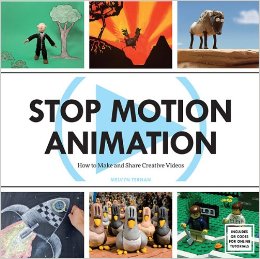An associate lecture in Animation at Sheffield Hallam University, Melyvn Ternan, last year, October, launched a book for Stop Motion fans in US and UK titled ‘Stop Motion Animation: How to Make & Share Creative Videos’.
 The book is available in French, Spanish, Italian and Chinese languages in these countries and can be purchased from Amazon sites and costs around Ł15.
The book is available in French, Spanish, Italian and Chinese languages in these countries and can be purchased from Amazon sites and costs around Ł15.
AnimationXpress.com got an opportunity to converse with Melvyn to know about the visions, planning and approaches that he followed for writing the book!
Hi Melyvn, Thank you for speaking to AnimationXpress.com,please tell us more about you?
Thank you! I’m presently a lecturer in animation at Sheffield Hallam University, teaching both undergraduate and postgraduate students studying in the BA (Hons) & M Art Animation courses. My background is in animation having completed a degree in Animation 2001 at the University of Lincolnshire and Humberside, England. Before this I did a foundation art and design course in Northern Ireland where I am originally from. Growing up, I was most keen on practicing art and also actively taking part in performance pieces during my secondary school years. After graduating from my degree in animation in 2001 I moved to Bristol and worked for Bolex Brothers, co-founded two animation companies “Collision Films” (2002) and “Paradise Pictures” (2003). After working for so many other people on various projects, I set up my own freelancing company Melmation in 2006 and still freelance to this day as well as teaching at Sheffield Hallam University.
2006 and still freelance to this day as well as teaching at Sheffield Hallam University.
Great, so how did ‘Stop Motion Animation: How to Make & Share Creative Videos’ happen?
I was approached by Rotovision, Brighton, England to write a book on Stop Motion Animation after they had found some forum posts online where I was helping people out with their questions on Stop Motion problems. They liked how I responded to people’s questions with clear advice and so they decided to contact me about writing the book. Whilst writing a book on Animation was never at the forefront of my mind, I decided to do it as I had found that when I was growing up (and even now) most books on the subject could be patronising and not give actual useful information on starting out in the subject. If I could be a part of writing something that could help people get into animation, I wanted to do it.
What are the key topics that you have covered in this book?
Pre Production for animation covering story boards, timing and materials / equipment choice. Stop Motion Animation production covering LEGO animation, post-it note animation, plasticine animation, puppset animation, claymation, cut out animation, chalk Board / whiteboard animation and Smartphone animation. Post production for animation covers converting an image sequence to movie files, how to perform basic editing and how to export your edited animation for upload to YouTube or Vimeo. The book does not cover sound recording/editing for animation as this is a whole other area and there simply wasn’t enough room in the book to cover it properly.
 And how would these topics help a reader?
And how would these topics help a reader?
First, I wanted the book to take away any preconceptions of difficulty in the readers’ mind about Stop Motion based animation. I wanted to simplify the process and show them how to use free, medium and high cost solutions so that they could see how easy it is to get started with Stop Motion animation, all whilst keeping the information relevant no matter how far they wanted to develop after trying something out in the book. The case studies of other work from animators around the world were there to inspire the reader, with many of the case study animators using simple or basic techniques to achieve good quality work. So this book is really for people starting out but also caters for people looking for inspiration in other areas of Stop Motion that they might not have thought about trying.
What was the vision and approach that you followed for developing the book?
I wanted to give a fully rounded explanation of the Stop Motion discipline from pre-production, production and post-production as well as offering advice and tools to complete novices. My direction with the book was to put as much relevant information in there as possible, information that would be as relevant to someone starting out as to someone who has some Stop Motion experience. This was tough to do as the book could only be so long and each page could only have so many words so I had to leave a few things out such as pixilation and animation performance. I put as much as I could into the book in such a way that people could build from it and develop the other skills themselves. I am a firm believer that if you give someone good, relevant basic advice on a topic, they can develop themselves better.
Stop motion being a vast topic, you must have taken a lot of time to write the book, isn’t it Melyvn?
Well, the book was written, from scratch, in about four months. This included creating the index, planning and writing the chapters, finding/interviewing/writing the case studies, animating an example for each chapter in the animation production section, recording screen casts for the post production section and taking the 350 photographs in the book (which I had to set up).
What was the research that you did?
All the information in the book was written from my own previous knowledge. The only parts I had to research were the parts on plasticine as this varies around the world, so I wanted to explain the different types. Having only ever used and only having ever known about British plasticine, I had to research what other countries use. I also had to research the case studies. I wanted to use lesser known case studies but still amazing short animations created by animators from around the world so as to show what could be done with the different techniques I cover in the book (LEGO, post-it note animation etc) So many animation books show the same pieces of work as case studies, I wanted this to be different and give the people behind the case studies a chance to have their amazing work featured in the book.
You must have across many challenges too?
Well, yes, Time was a prime challenge! Finding the time to write it was the difficult part. I wrote and created all of the content (except the images and answers given to me for the case studies by those people featured in the case studies) all by myself. The most time consuming part of making the book were the images showing how things are done. Each of these had to be set up bespoke and so this took a lot of time as each image took on average one–two hours to set up and shoot. I was finishing the book when my teaching started back at University, so I was teaching all during the day, going home and prepping for the next day’s classes and then at about 10pm or 11pm. I would work on the book until the early hours of the morning. Some mornings I wouldn’t get to bed until 4am or 5am. But I am used to that! Animation itself takes a long time to do so it wasn’t out of the ordinary for me. I met every deadline for Rotovision and finished the main writing and creation of the book on the 24 October 2012.
Please share with us some reactions of readers who read the book?
I have had some people tell me they really found the book helpful and inspiring, especially with the case studies and online video examples. Some have mentioned that it is good to see different work shown in the case studies. Animators with experience have told me that the book has inspired them to try other Stop Motion techniques, different to those that they currently practise. Overall, the main thing I get told is that the book is a really solid basis to understanding Stop Motion animation and how to go about trying it out. All of these responses make me feel very proud as that is exactly what I set out to do when writing the book and I feel blessed to have had the chance to help people out with the information I have given in the book.

